Even before the COVID-19 pandemic hit, there was a strong case to cut immigration, which has run at turbo-charged levels for 15 years:
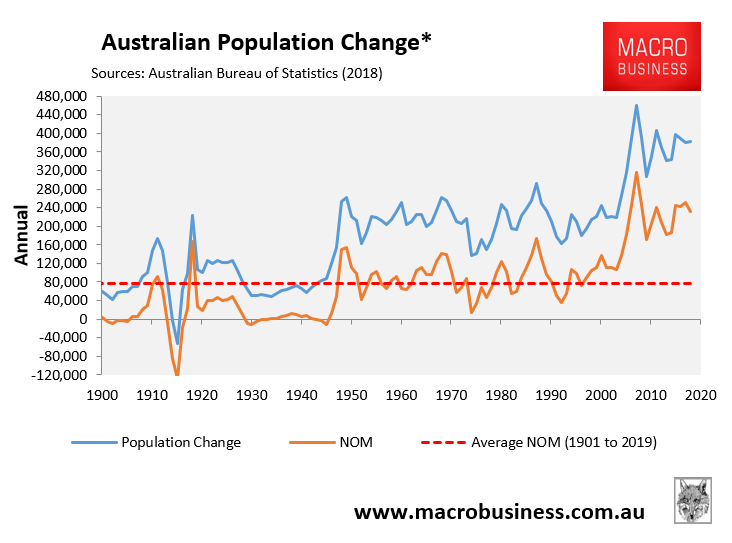
First, Australian real wage growth has remained stillborn for nearly 10 years:
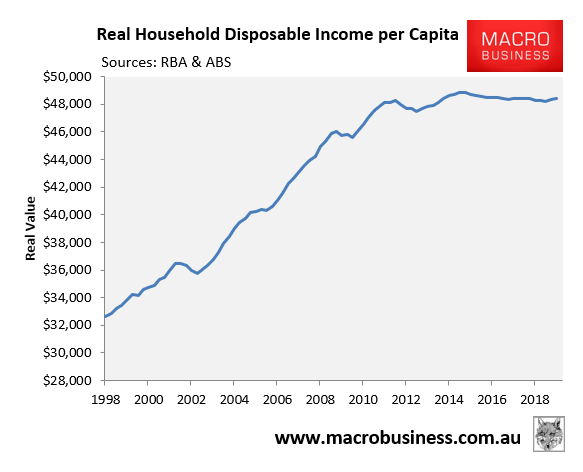
Australia’s labour underutilisation rate has been stuck at stubbornly high levels:
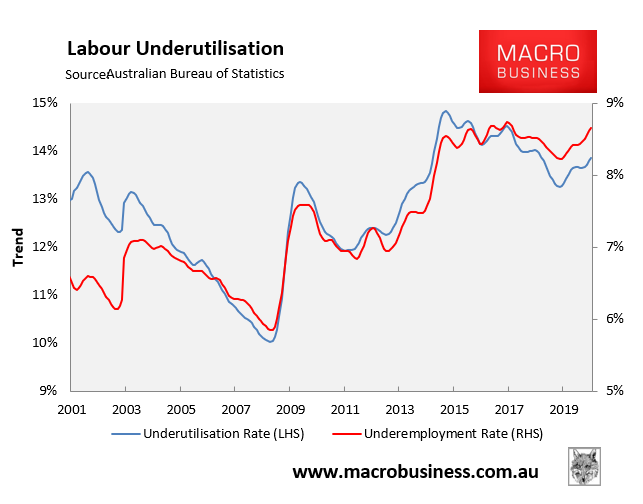
Whereas average monthly hours worked has collapsed to record lows:
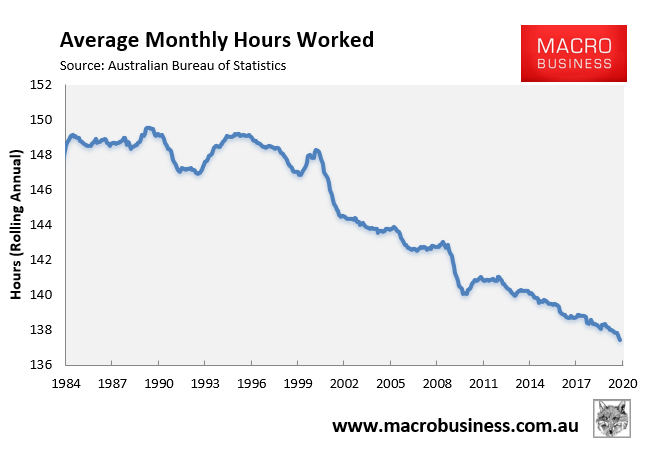
All three indicators point to an Australian labour market that has been chronically oversupplied, driven by the tidal wave of migrants, both temporary and permanent.
When combined with the negative impacts on housing affordability, congestion and overall amenity in our major cities, it is clear that Australia’s mass immigration experiment has unambiguously reduced living standards for the typical Australian household.
Now that the COVID-19 pandemic has hit, the need to slash immigration has become critical.
Unemployment is expected to rise to levels not seen since the 1930s Great Depression and Australian households are facing heavy income losses.

Thus, the absolute last thing Australian workers need is to be competing for scarce jobs with hundreds of thousands of migrant workers arriving every year.
Thankfully, Labor’s immigration spokesperson, Kristina Keneally, has entered the fold recommending that Australia cut immigration and “put Australian workers first”.
The next move for Labor is to turn rhetoric into policy.
Below are suggestions on how to practically reduce Australia’s immigration intake, both temporary and permanent, to sustainable levels.
Temporary migration:
The number of temporary visas outstanding reached absurd levels at the end of 2019, at nearly 2.5 million people:
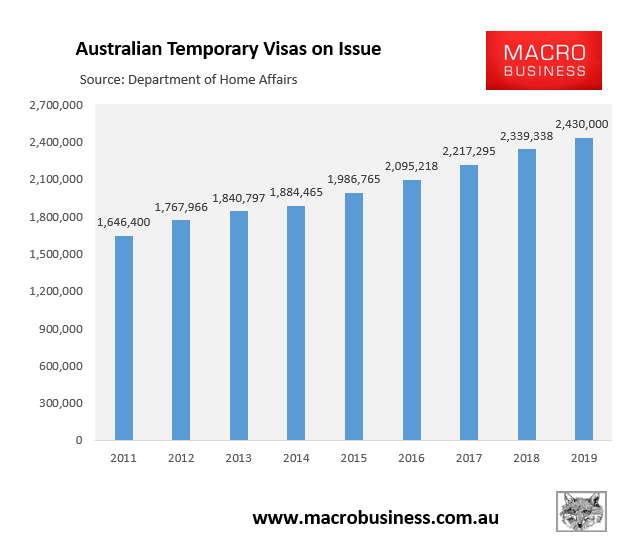
The first step to lowering the number of temporary migrants should be to significantly lift the Temporary Skilled Migration Income Threshold (TSMIT) from $53,900, which is well below the median Australian wage of $1,100 per week ($57,200 p.a.), according to the ABS:

This TSMIT wage floor has now fallen $3,300 (6%) below the median income of all Australians ($57,200), which includes unskilled workers. Thus, the TSMIT has incentivised employers to hire cheap migrants instead of local workers, as well as abrogated the need to provide training.
The wage floor for all skilled migrants (both permanent and temporary) should be set at least at the 75th percentile of earnings (preferably higher).
This would ensure that the temporary migration scheme is used sparingly by businesses to employ only high skilled migrants, not as a general labour market tool for undercutting local workers and eliminating the need for training.
Second, the federal government should lift English-language and financial requirements for international students, alongside limiting work opportunities.
Raising entry standards would ensure a smaller number of high quality international students, while also ensuring they are financially independent and not reliant on work for income.
In turn, this would lift export revenue per student and reduce competition in the workplace. It would also ensure that students come to Australia to study, not for ulterior motives, such as to work and/or to gain permanent residency.
These measures alone would dramatically reduce temporary migration into Australia.
Permanent migration:
The permanent migrant program is dominated by the ‘skilled stream’, which has set aside 108,000 places for so-called ‘skilled’ workers:
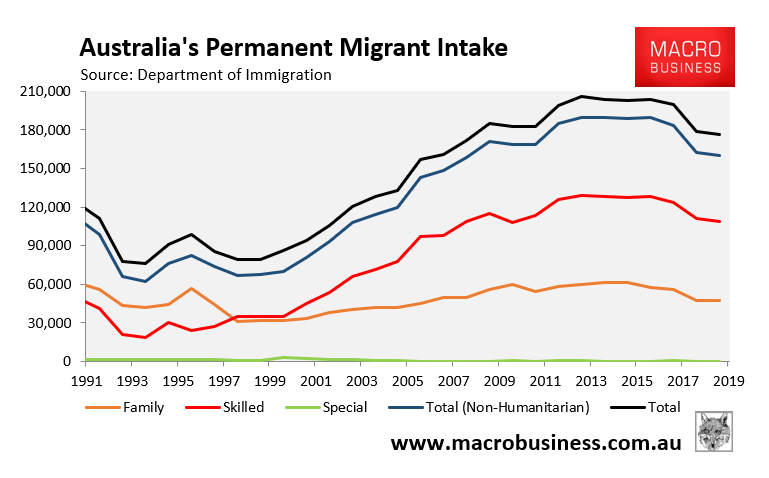
Even before the COVID-19 pandemic hit, this skilled stream was highly dubious. There was no evidence that Australia was experiencing ‘skills shortages’ that warranted such a strong intake.
We also know that Australia’s skilled migrant program has been widely rorted, attracting migrants to areas already heavily oversupplied with workers (e.g. accounting, engineering and IT), with most of these migrants employed at levels well below their claimed skills set.
‘Skilled’ migrants generally also have significantly higher unemployment and underemployment than the Australian born population, as illustrated by the ABS:
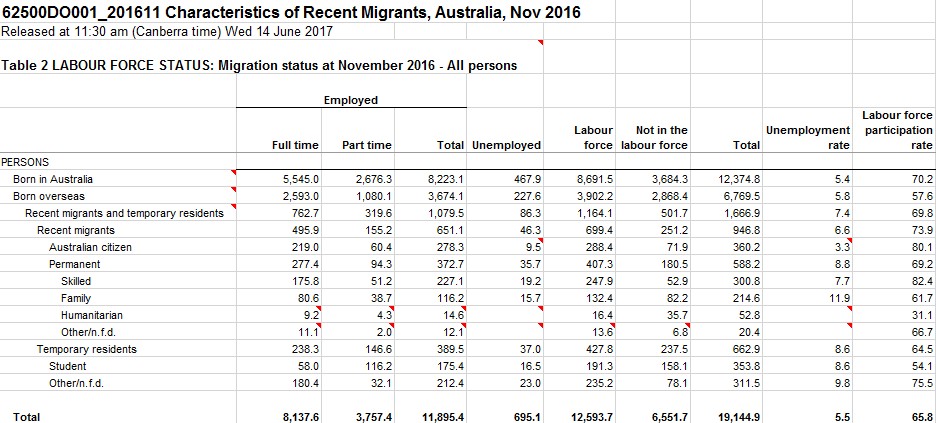
To make matters worse, the ABS’ latest Personal Income of Migrants survey for 2016-17 revealed that skilled permanent migrants that have arrived in Australia since 1 January 2000 earned an appallingly low median income of only $55,900 in 2016-17.
In a similar vein, the Department of Home Affairs’ Continuous Survey of Australia’s Migrants revealed that the median full-time salary 18 months after being granted a skilled visa was just $72,000 in 2016, below the population median of $72,900 (which includes unskilled workers).
Thus, like the temporary skilled visa system, the permanent program has unambiguously undercut workers and contributed to Australia’s poor wage growth.
With Australians facing mass unemployment, and skills shortages virtually non existent across the economy, there is zero rationale for maintaining such a strong permanent migrant program.
Instead, the ‘skilled’ program should be phased back to historical levels of around 35,000, and be reserved only for truly world-class leaders in their field that Australia cannot foster internally.
Moreover, these highly skilled migrants should have an income pay floor set at least at the 75th percentile of earnings (preferably higher), as for temporary ‘skilled’ migrants.
No longer should Australian employers be allowed to simply ‘grab a migrant’ to fill ordinary positions in the labour market cheaply. Instead, they would have to lift wages to attract workers (thus countering anaemic wages growth), as well as commit to training local workers.
Let’s also not forget that many migrants come to Australia on temporary visas with the hope of transitioning to a ‘skilled’ permanent visa.
Therefore, if Australia was to remove the carrot of permanent residency by slashing the ‘skilled’ intake, it would also reduce the flow of temporary migrants, since the two areas are intrinsically linked.
An easy ‘sell’ for Labor:
Cutting immigration in this way is an easy sell for Labor. All it needs to argue is:
- That an excessive flow of migrant workers are displacing locals, reducing employment opportunities and lowering wage growth.
- That excessive immigration is driving up demand for housing, pushing prices beyond the reach of locals, especially in Sydney and Melbourne.
- That excessive immigration is overrunning infrastructure, reducing amenity and liveability, and pushing up the cost of living.
Most Australians know these to be true and would resonate with these common-sense arguments.
Labor should also state that it is merely seeking to lower immigration back toward the historical (pre-2004) average, and that the new lower intake would still be at the higher end of developed nations.
If Labor wants to have any chance of winning the next election, it must return to its working class roots and represent the interests of regular Australians over inner-city progressives. Otherwise it will remain in the political wilderness.

